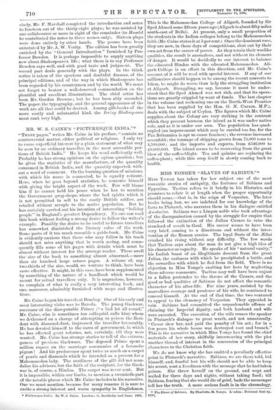MR. W. S. CAINE'S " PICTURESQUE INDIA."* "THESE pages," writes
Mr. Caine in his preface, "contain no controversial matter, either political or religious. I only try to rouse superficial interest by a plain statement of what may be seen by an ordinary traveller, in the most accessible por- tions of British India." He keeps his word sufficiently well. Probably he has strong opinions on the opium question ; but he gives the statistics of the manufacture, of the quantity consumed in British India, and the quantity exported, with- out a word of comment. On the burning question of missions, with which his name is connected, he is equally reticent. Here, when he goes beyond statistics, he contents himself with giving the bright aspect of the work. Few will blame him if he cannot hold his peace when he has to mention the Government grog-shops, where the bad spirits which it is not permitted to sell to the costly British soldier, are retailed without scruple to the native population. But he has certainly carried out his intention of interesting "holiday people" in England's greatest Dependency. No one can read this book without feeling a strong desire to follow the writer's example. Possibly the desire to be useful to future travellers has somewhat diminished the literary value of the work. Some parts of it too much resemble a guide-book. Mr. Caine is evidently anxious that those who may follow in his track should not miss anything that is worth seeing, and conse- quently fills some of his pages with details which must be almost without interest for the average reader. These swell the size of the book to something almost abnormal,—more than six hundred large octavo pages. A volume of, say, two-thirds of the size, would, we venture to think, have been more effective. It might, in this case, have been supplemented by something of the nature of a handbook which would be meant for actual travellers only. It is ungracious, however, to complain of what is really a very interesting book, and one, moreover, admirably furnished with maps and illustra- tions.
Mr. Caine began his travels at Bombay. One of his early and most interesting visits was to Baroda. The young Gaekwar, successor of the disreputable Prince (" a bad lot all round," Mr. Caine, who is sometimes too colloquial, calls him) whom we dethroned on a charge of attempting to poison the Resi- dent with diamond-dust, impressed the traveller favourably. He has devoted himself to the cares of government, in which he has effected great reforms, not, certainly, till they were wanted. Mr. Caine has strange stories to tell of the extrava- gances of previous Gaekwars. The deposed Prince spent a million rupees on the marriage ceremonies of a favourite pigeon ! And his predecessor spent twice as much on a carpet of pearls and diamonds which he intended as a present for a Mahommedan lady. The costliness of the gift did not scan- dalise his advisers, but the faith of the recipient, for the Gaek- war is, of course, a Hindoo. The carpet was never sent. But it is impossible, within our limits, to mention a twentieth-part of the notable places which Mr. Caine includes in his narrative. One we must mention, because for many reasons it is sure to excite a strong interest and warm sympathy in Englishmen
• Picturesque India. By W. S Caine. London : O. Rontledge and Sons. 1890.
This is the Mahommedan College of Aligarh, founded by Sir Syed Ahmed some fifteen years ago (Aligarh is about fifty miles south-east of Delhi). At present, only a small proportion of the students in the Indian colleges belong to the Mahommedan faith (Mr. Caine states it at 5 per cent.) Once the dominant race, they are now, in these days of competitions, shut out by their own act from the career of power. As they retain their warlike qualities, the result is anomalous, and not without its element of danger. It would be decidedly to our interest to balance the educated Hindoo with the educated Mahommedan. Ali- garh College is an effort in this direction, and Mr. Caine's account of it will be read with special interest. If any of our millionaires should happen to be among the recent converts to Islam, he might do worse than help the struggling institution at Aligarh. Struggling, we say, because it must be under- stood that Sir Syed Ahmed was not rich, and that its opera- tions are greatly crippled by want of funds. The last chapter in the volume (not reckoning one on the North-West Frontier that has been supplied by the Hon. G. N. Curzon, M.P.), deals with the subject of Ceylon. The figures which Mr. Caine supplies about the Colony are very striking in the contrast which they present between the island as it was under native rule, and as it is under our own. The population has quad- rupled (an improvement which may be carried too far, for the Pax Britannica is apt to cause famines) ; the revenue increased sevenfold; the tonnage of shipping grown from 75,000 tons to 4,500,000; and the imports and exports, from £546,000 to £9,800,000. The island seems to be recovering from the great blow of the coffee-blight. Tea and quinine are replacing the coffee-plant ; while this crop itself is slowly coming back to health.


















































 Previous page
Previous page